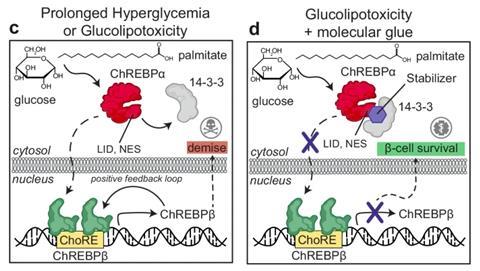A collaboration between researchers from Eindhoven, Essen and New York is proposing a ‘molecular glue’ as a treatment for type 2 diabetes. The glue targets the ChREBPα protein involved in processing glucose and activating insulin production.
In 2020, Luc Brunsveld’s group at Eindhoven University of Technology published a study on the interaction of small molecules with proteins outside of the cell. The group of Donald Scott, Icahn School of Medicine at Mount Sinai (New York), was interested in applying these insights to type 2 diabetes and therefore contacted Eindhoven for a collaboration. Emira Visser, at the time a PhD student in the Brunsveld group, said: ‘This is one of my favourite projects I have worked on.’
Overproduction
The 14-3-3 protein, which is a key topic for Brunsveld’s research group, interacts with the ChREBPα protein in the cytosol of beta cells. ChREBPα is involved in processing glucose through activating the production of beta cells and insulin. When there is a glucose flux, the two proteins split and ChREBPα activates the ChREBPβ transcript in the cell nucleus, leading to proliferation of beta cells. But when high glucose levels persist, a strong positive feedback response is triggered. This causes ChREBPβ to bind to its own activation site, resulting in an overload of ChREBPβ, which in turn leads to glucolipotoxicity and the death of beta cells. The central question in this study is how to prevent this destructive overproduction.

To prevent the unwanted overproduction of ChREBPβ, the interaction between ChREBPα and the 14-3-3 protein is an important target. As long as these two proteins are bound together, the production of ChREBPβ in the cell nucleus is limited to normal levels. ‘The interaction between these proteins is a regular biological phenomenon that we put to use. Thus, we are not introducing a completely new process in the cell,’ Visser says. ‘By “glueing” proteins together, you can inhibit their function’, Visser explains. Taking advantage of this principle, the researchers designed a molecular glue that keeps the proteins together, thereby inhibiting the function of ChREBPα.
Fluorine magic
‘It is important to tailor the molecular glue specifically to the ChREBPα - 14-3-3, because the latter interacts with multiple different proteins in the cell,’ says Marloes Pennings, who is a PhD student in the Brunsveld group. The natural stabiliser AMP was used as starting point for designing the new molecular glue. It has a similar mode of action but differs considerably from AMP in shape and structure. ‘For the glue to be effective, it must be able to enter the cell. But as it contains a negatively charged phosphonate group, we expected this to be problematic because the cell membrane is negatively charged. But surprisingly, it worked really well,’ Visser says.
The solution was provided by the group of Markus Kaiser at the University of Essen (Germany). They were responsible for the synthetic-organic work within the collaboration and came up with the plan to introduce fluorine groups. ‘That worked like magic,’ says Visser. ’Even with compounds that initially proved to be ineffective’.
The molecular glue settles into the pocket that is created when the two proteins bind each other. Visser: ‘This protein-protein binding is essential. Without it, adding the glue is pointless.’ Even though this glue is specifically designed for protein-protein interaction, the team sees opportunities to build on these insights and explore applications in other diseases. Currently, the first in vivo experiments with the molecular glue are ongoing at Mount Sinai in New York. In a mouse model, the team there is evaluating changes in glucose levels and the clearance of the glue in the body.
Liora Katz, Emira Visser, Kathrin Plitzko, Marloes Pennings, et al., Molecular glues of the regulatory ChREBP/14-3-3 complex protect beta cells from glucolipotoxicity, Nature Communications (2025), doi:10.1038/s41467-025-57241-7













Nog geen opmerkingen